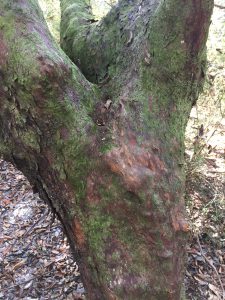During a recent hike through wooded property in Walton County, our Florida Master Naturalist class came across a stunning example of an American Beech tree (Fagus grandifolia). As we looked closely at its thick, sinewy trunk (often compared to an elephant’s skin), the bark changed hues from a deep red to silvery gray and brown. A hardwood, it has been used over the years to make furniture, railroad ties, and beer barrels. Like many of the local hardwood species, beech wood holds up to decay when exposed to water and early settlers used it to build mills and water wheels.

The colorful, smooth bark of a beech tree is eye-catching and strong. Photo credit: Carrie Stevenson
During the growing season, the beech tree can be identified by its distinctive dark green, tooth-edged leaves. Beeches are deciduous but have the unique quality of usually keeping dead leaves on their branches all winter, which also helps with identification in the forest.
The most fascinating observation, to me, was the series of tightly swirled branch buds ready to sprout at the tips of each new branch. So pointed that they’re easily confused as thorns, these long protrusions will eventually grow into new branches.

These four buds formed as an “emergency” response to the branch being cut and will eventually replace it. Photo credit: Carrie Stevenson
At the end of one branch that had been cut, the tree’s internal “emergency response” system formed four new immature branches, which had the intimidating appearance of a claw. Eventually, one of these buds will outcompete the others and grow into a new branch.
Beeches are of course known for the beech nut, eaten by humans and wildlife alike. If you’re considering a beech for a home landscape, be sure you have a wide open space with moist soil, as a mature beech can grow up to 75 feet high and 40-60 feet wide. Its low branches create a lot of shade, so understory plants are usually unnecessary or even impossible to grow.
For more information on these interesting native trees and others like it, contact your local UF IFAS Extension Office or visit the UF Landscape Horticulture page.
- Wax Myrtle–a Native Evergreen - December 26, 2025
- Yucca–A Tough and Versatile Native Plant - November 26, 2025
- Blazing Star - November 6, 2025
